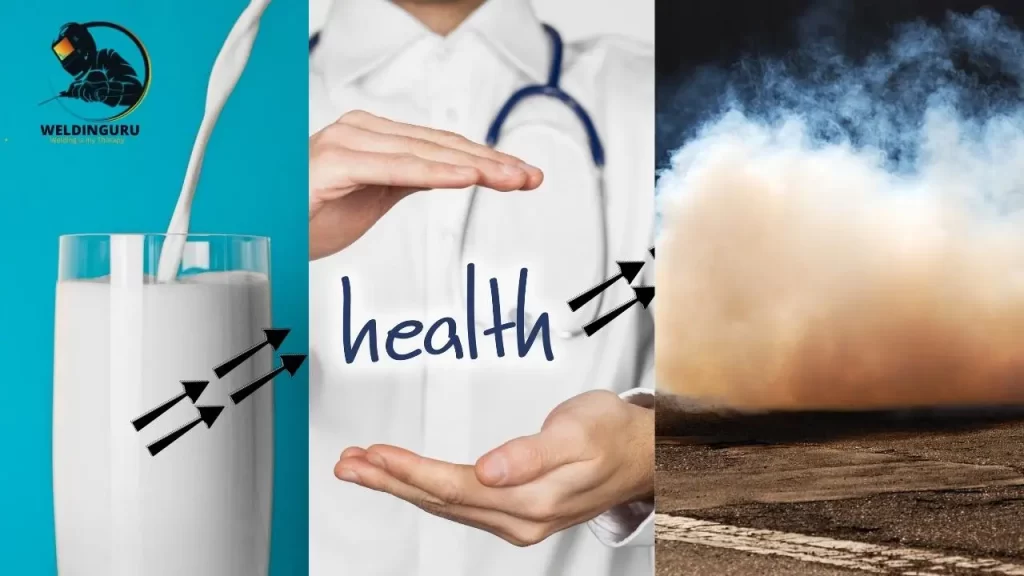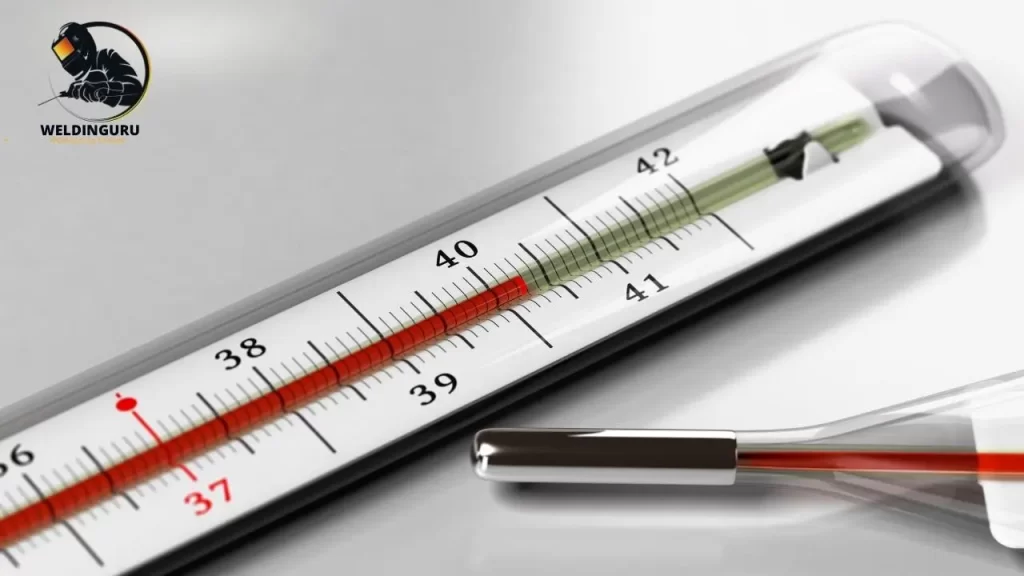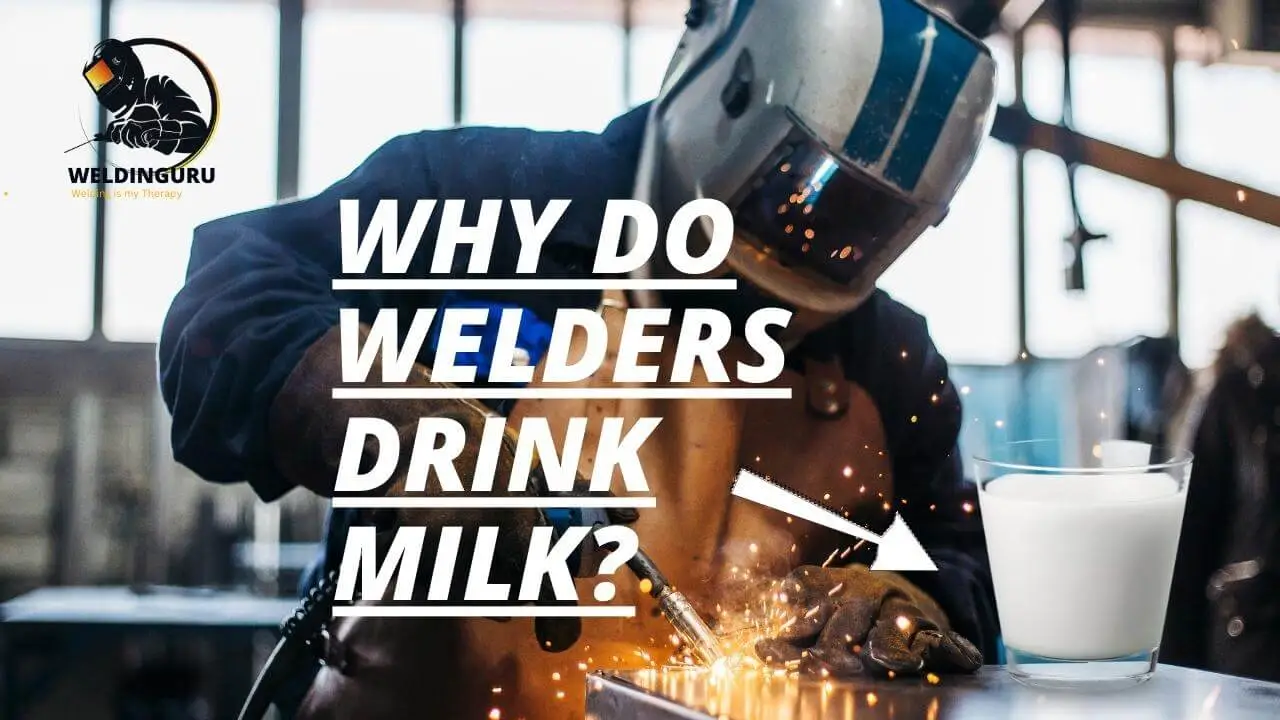Cancer isn’t pretty. There are chemicals, metal shavings, gases, and welding wire bits floating around in the air. Unfortunately, welders aren’t immune from some of these toxins getting into their systems.
In fact, welders have one of the highest instances of metal fume fever which is caused by these damaging fumes. The most common ailment is a mild fever with flu-like symptoms, but if left untreated, it can cause very serious sicknesses like pneumonia.
Why do Welders drink Milk?
Welders drink Milk to wash down the lung-burning carcinogens they inhale while welding. In addition, welders in the shipbuilding industry take calcium supplements to avoid developing Metal Fume Fever. But the reason for this remedy is in doubt. They are myths, not facts.
Welding generates extreme amounts of metal fumes, some of which are known to be carcinogenic, most of which are unknown. Even the metal fumes with known health threats have no exposure limits.
As a result, welders are at extreme risk of developing a debilitating illness called Metal Fume Fever (MFF). Let’s understand the whole thing.
Does Milk Protect Against Welding Fume Poisoning?

The concept is that consuming dairy products will promote the excretion of heavy metal contaminants and reduce their absorption by the body. This theory is based on the fact that calcium in dairy products binds to heavy metals, both preventing ingestion and promoting excretion.
So, Turning to science, it is known that the body will absorb calcium from Milk, which will fill spaces in the body normally occupied by other heavy metals (such as zinc and cadmium), lowering the potential intake of these dangerous substances or metal while welding.
Calcium is absorbed by the body through the digestive system, and heavy metals are absorbed through the respiratory system. Therefore, drinking Milk will not combat the effects of inhaling toxic fumes from welding.
Furthermore, if a person does not maintain a healthy diet and does not already have adequate levels of calcium in his or her system, then additional calcium will not be absorbed.
So that Proper use of respiratory protection during welding prevents heavy metals such as zinc, lead, and cadmium from being absorbed by the respiratory system. Milk and calcium supplements do not protect against these heavy metals as they absorb through a different pathway.
Also See:
Welding: keeping Milk in the Mouth Acts as an Effective Filter

theories suggest that welders may have held the Milk in their mouths while welding, as a means of protection from the toxic fumes, spit it out on the welded area after a job was completed, and then used the Milk to try to scrub away any dirt.
The idea is ridiculous. Milk contains fats, which will clog the welder’s nose, making breathing difficult. The belief that holding Milk in your mouth while welding protects your lungs is completely false.
The myth stems from the fact that you are breathing through your mouth, but the Milk does nothing to protect you from inhaling toxic fumes.
So that is not at all true. Holding Milk in your mouth forces the welder to breathe through their nose because they have to do this in order to swallow the Milk.
In other words, the process relies on the digestive system, with the welding fumes being forced up through the nasal cavity and then into the lungs, where they can be absorbed by the welder’s respiratory system.
The best way to protect a welder’s lungs from the harmful fumes of welding is to wear a respirator rather than to simply hope for the best.
Metal Fume Fever – What is it, symptoms, prevention, and treatment

Metal fume fever (MFF) is a syndrome characterized by arthralgia, fatigue, and a flu-like illness that is caused by inhaling the fumes of hot galvanized steel.
Welders who join galvanized steel and other types of metal can become ill from a type of fever known as metal fume fever.
That is one type of fever caused by the inhalation of metals in newly welded galvanized steel. The fume fever can be avoided by avoiding freshly formed metal oxides produced from the welding process.
Symptoms of Metal Fume Fever
When it comes to working with galvanized steel, welding, and brazing, the risk is there. The symptoms of metal fume fever have been known to make work very difficult when you are out welding or grinding. We do not want you to get sick.
During welding on galvanized steel, zinc fumes are released into the air. Depending on humidity, factors such as ventilation and temperature may increase or decrease exposure to zinc. Exposure to zinc fumes may cause Metal Fume Fever.
The most common symptoms of MFF are Acute myelofibrosis first shows with fever, chills, and symptoms of a heavy cold or flu. Then, there is an overall feeling of malaise (feeling run down) and body aches, chest pain, and coughing.
The patient might also have other more specific symptoms such as pain in the jaw on chewing, metallic taste in the mouth, tenderness over the heart, and muscle weakness (especially involving legs). One will also note that there are signs of leukocytosis (above 100,000 WBC/µL), which means a high white blood cell count.
Oxides released by welding contain chemicals that can cause headaches, fever, chills, muscle aches, nausea, fatigue, joint pain, changes in blood pressure, chest pains, shortness of breath, and pneumonia.
You may have trouble concentrating, and your coordination may be off. You may feel mentally foggy and exhibit a lack of attention to detail. Symptoms usually strike within hours of exposure to noxious fumes. They persist for about two days. However, repeated exposure to these fumes seems to create a tolerance to them.
Prevention of Metal Fume Fever
The American Welding Society has 45 different health and safety fact sheets for welders, including guidelines for working in a factory setting, engineering controls to reduce or eliminate hazards in the workplace, respiratory protection, and awareness of hazardous fumes.
Inhaling welding fumes is a serious health hazard. The toxic vapors increase the risk of cancer. The fumes also can cause lung damage and hinder your breathing.
To Reduce the Risk of Inhaling Fumes:
- You should also keep your head out of the fumes if you are welding. A couple of weeks ago, I had to weld something in a school bathroom. The ventilation was bad, but the worst part was that there was a big poster directly behind me that read: “DON’T BREATHE FUMES.”
- Only use oxygen and acetylene-fueled torches or other equipment when ventilation is functioning properly.
- Minimize or eliminate the use of open flames, such as propane or methane, in enclosed areas.
- Use a respirator approved by NIOSH to help filter out dangerous fumes.
- Checking air quality regularly to ensure that welders are not exposed to fumes or airborne contaminants that exceed established limits. Make sure proper precautions are taken if welding outdoors.
- Masks should be used to protect your lungs from harmful gases, particulates, and fumes during welding.
- Also important to consider is your personal safety when you work with welding equipment. You should always wear protective eyewear.
- The most common way to avoid being injured is by wearing personal protective equipment (PPE). This includes helmets, face shields, leather gloves, and long sleeve shirts.
Welding is one of the things that a lot of people do nowadays, but it can be very dangerous if you don’t know what you are doing.
For example, if you cut off your fingers or burn them, then it will not only hurt but also be very expensive because you need medical treatment and possibly surgery, depending on how bad it is.
You can also get something called “arc eye“, which means that your eyes get burned and that hurts and itches for a long time.
It is also very dangerous to other people who are standing around you when you are welding because they can get hurt from the sparks or from breathing in too much smoke from the welding process.
Treatment of Metal Fume Fever
Treatment: To help relieve some of the symptoms stemming from both kinds of fever–such as nausea, vomiting, and headaches–it’s recommended that you try to take in some oral hydration or fluids by mouth.
You should also try to rest for at least 24 hours before taking aspirin or cold medicine, even though most people with these conditions tend not to get relief this way.
Welders Beware: Pasteurized milk may be Hazardous to your Health
The Health and Safety Executive (HSE) warns in a disclaimer on its official website: “Don’t believe the stories about drinking Milk before welding. “There’s no denying it; welding is a dangerous trade.
However, contrary to popular belief, you cannot ‘build up an immunity or be protected from the debilitating effects of metal fume fever simply by drinking Milk.
We don’t know where this story originated, but it certainly isn’t true! It may be that those who write service manuals that you read on work time started the rumor in order to sell machines to remove fumes and make welding safer.
So that experts say that drinking a glass of milk before you start welding can prevent metal fume fever. This isn’t true. It’s a construction myth that no one seems to be able to explain.
Some believe it was inspired by welders’ diet of bacon and eggs, with the side order of a glass of milk to wash it down. Others suggest the story got started by the unusual working times many welders keep – early morning, late at night, and sometimes 24-hour shifts.
The truth is: If you love welding, you know how welders act when they’re burning themselves out – drinking a glass of something cold works wonders to clear your head.
Bottom Line
Are you working with galvanized steel? Do you work amidst flux-rookie rodillas? Are you planning to weld in a shop where there is no ventilation or exhaust fan? Don’t be like that lunk-head, Wiggly Willie.
Have an idea of how things really are before you get into trouble. Before starting work, always know what you are working with.
That way, if asked at the scene of a ruckus, “What were you thinking?!” You’ll know what to answer: “I was imaging–I mean imagining–a duly ventilated, exhaust-fanned, flux-rooguned situation.”
So, Working with galvanized steel can be a dangerous process if you don’t understand your working conditions. For example, welding in the rain increases the likelihood of a bad outcome by about tenfold.
So it’s important to pay attention to the situation and make sure the area you are working in has adequate ventilation and proper exhaust systems. Gulping welding fumes can be as bad for your health as anything else you put in your body.
However, through using a common-sense approach like wearing a mask, vacuum, respirator, or another type of gas filtering device, you can limit your exposure to cutting oils, gases, and vapors.
Related Posts:
